Australian Paper Industry: Automation Warehousing Research Proposal
VerifiedAdded on 2021/04/21
|13
|4015
|87
Project
AI Summary
This research proposal investigates the potential of automated warehousing within the Australian paper industry. It begins with an introduction outlining the industry's growth, the benefits of automation, and the research problem, which focuses on replacing labor-intensive warehousing with automated systems. Aims and objectives are set to evaluate automation techniques, identify related issues, and analyze cost-benefit aspects. The literature review covers automation warehouse overviews, its significance, and the issues involved. The methodology section details the research approach, including the evaluation of technological, economic, risk, and labor issues. Expected outcomes include the analysis of cost-benefit relations. The research aims to provide insights into the industry's transition towards automation, considering technical, economic, and labor-related challenges.

RESEARCH PROPOSAL
TABLE OF CONTENTS
1
TABLE OF CONTENTS
1
Paraphrase This Document
Need a fresh take? Get an instant paraphrase of this document with our AI Paraphraser
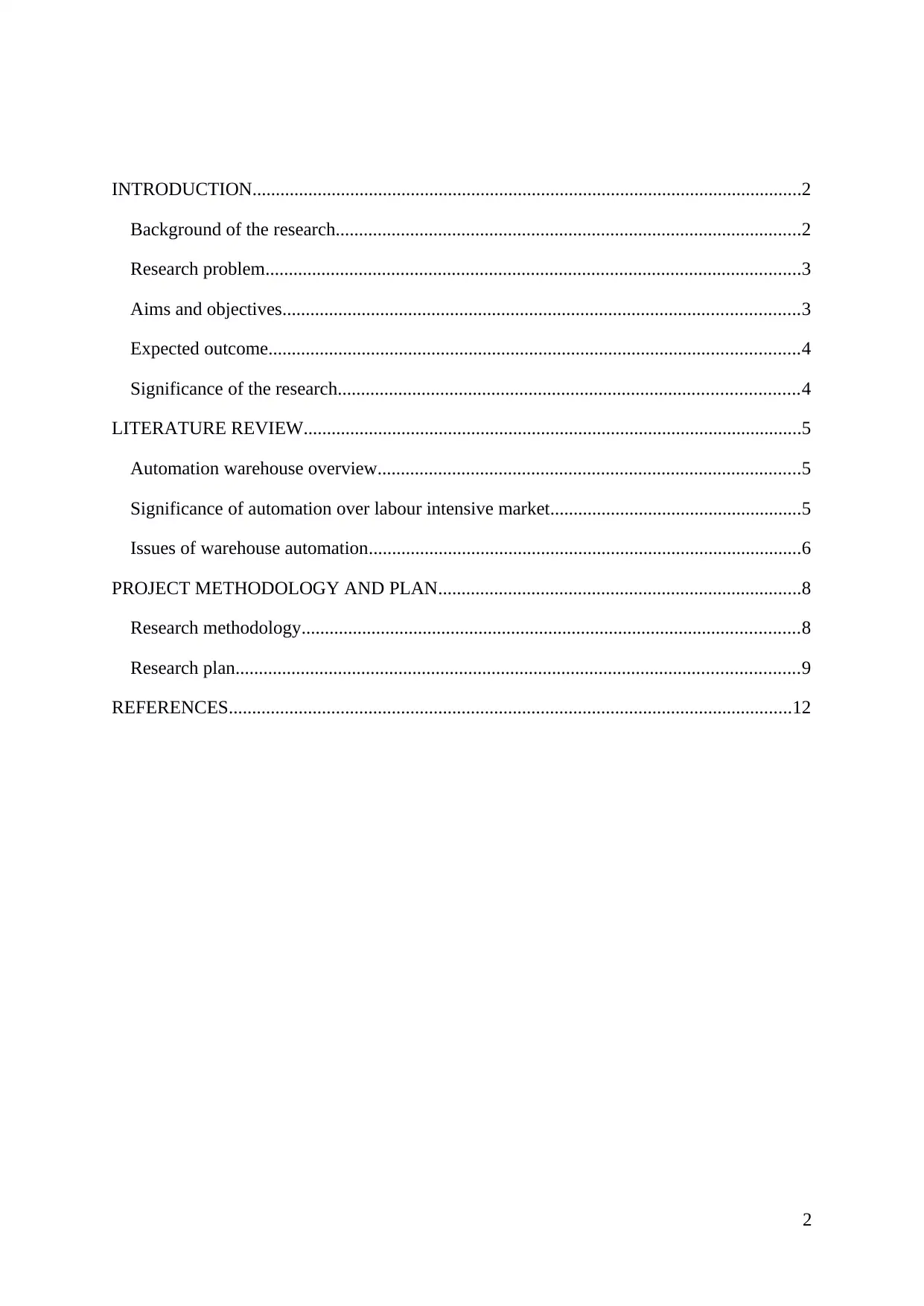
INTRODUCTION......................................................................................................................2
Background of the research....................................................................................................2
Research problem...................................................................................................................3
Aims and objectives...............................................................................................................3
Expected outcome..................................................................................................................4
Significance of the research...................................................................................................4
LITERATURE REVIEW...........................................................................................................5
Automation warehouse overview...........................................................................................5
Significance of automation over labour intensive market......................................................5
Issues of warehouse automation.............................................................................................6
PROJECT METHODOLOGY AND PLAN..............................................................................8
Research methodology...........................................................................................................8
Research plan.........................................................................................................................9
REFERENCES.........................................................................................................................12
2
Background of the research....................................................................................................2
Research problem...................................................................................................................3
Aims and objectives...............................................................................................................3
Expected outcome..................................................................................................................4
Significance of the research...................................................................................................4
LITERATURE REVIEW...........................................................................................................5
Automation warehouse overview...........................................................................................5
Significance of automation over labour intensive market......................................................5
Issues of warehouse automation.............................................................................................6
PROJECT METHODOLOGY AND PLAN..............................................................................8
Research methodology...........................................................................................................8
Research plan.........................................................................................................................9
REFERENCES.........................................................................................................................12
2
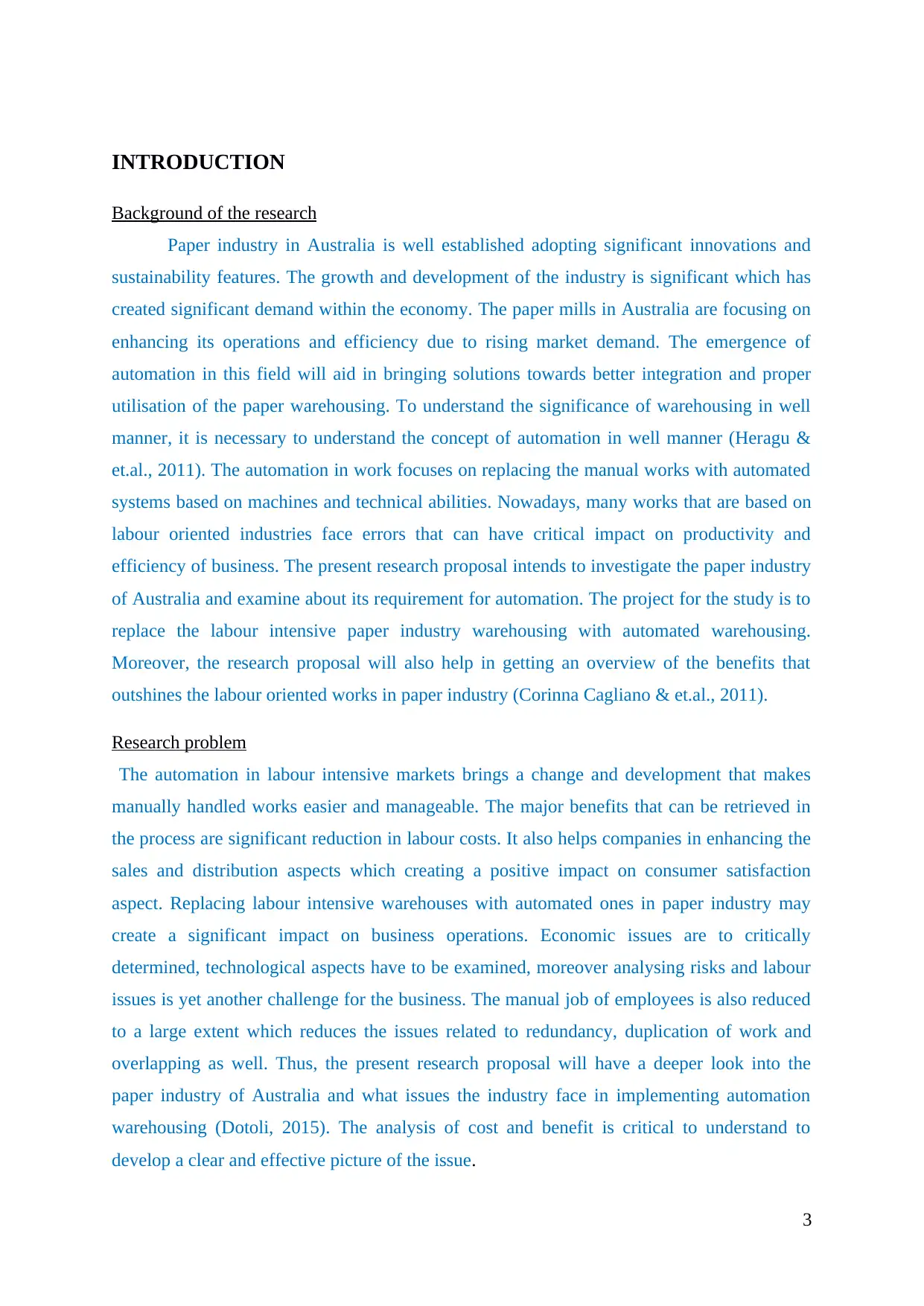
INTRODUCTION
Background of the research
Paper industry in Australia is well established adopting significant innovations and
sustainability features. The growth and development of the industry is significant which has
created significant demand within the economy. The paper mills in Australia are focusing on
enhancing its operations and efficiency due to rising market demand. The emergence of
automation in this field will aid in bringing solutions towards better integration and proper
utilisation of the paper warehousing. To understand the significance of warehousing in well
manner, it is necessary to understand the concept of automation in well manner (Heragu &
et.al., 2011). The automation in work focuses on replacing the manual works with automated
systems based on machines and technical abilities. Nowadays, many works that are based on
labour oriented industries face errors that can have critical impact on productivity and
efficiency of business. The present research proposal intends to investigate the paper industry
of Australia and examine about its requirement for automation. The project for the study is to
replace the labour intensive paper industry warehousing with automated warehousing.
Moreover, the research proposal will also help in getting an overview of the benefits that
outshines the labour oriented works in paper industry (Corinna Cagliano & et.al., 2011).
Research problem
The automation in labour intensive markets brings a change and development that makes
manually handled works easier and manageable. The major benefits that can be retrieved in
the process are significant reduction in labour costs. It also helps companies in enhancing the
sales and distribution aspects which creating a positive impact on consumer satisfaction
aspect. Replacing labour intensive warehouses with automated ones in paper industry may
create a significant impact on business operations. Economic issues are to critically
determined, technological aspects have to be examined, moreover analysing risks and labour
issues is yet another challenge for the business. The manual job of employees is also reduced
to a large extent which reduces the issues related to redundancy, duplication of work and
overlapping as well. Thus, the present research proposal will have a deeper look into the
paper industry of Australia and what issues the industry face in implementing automation
warehousing (Dotoli, 2015). The analysis of cost and benefit is critical to understand to
develop a clear and effective picture of the issue.
3
Background of the research
Paper industry in Australia is well established adopting significant innovations and
sustainability features. The growth and development of the industry is significant which has
created significant demand within the economy. The paper mills in Australia are focusing on
enhancing its operations and efficiency due to rising market demand. The emergence of
automation in this field will aid in bringing solutions towards better integration and proper
utilisation of the paper warehousing. To understand the significance of warehousing in well
manner, it is necessary to understand the concept of automation in well manner (Heragu &
et.al., 2011). The automation in work focuses on replacing the manual works with automated
systems based on machines and technical abilities. Nowadays, many works that are based on
labour oriented industries face errors that can have critical impact on productivity and
efficiency of business. The present research proposal intends to investigate the paper industry
of Australia and examine about its requirement for automation. The project for the study is to
replace the labour intensive paper industry warehousing with automated warehousing.
Moreover, the research proposal will also help in getting an overview of the benefits that
outshines the labour oriented works in paper industry (Corinna Cagliano & et.al., 2011).
Research problem
The automation in labour intensive markets brings a change and development that makes
manually handled works easier and manageable. The major benefits that can be retrieved in
the process are significant reduction in labour costs. It also helps companies in enhancing the
sales and distribution aspects which creating a positive impact on consumer satisfaction
aspect. Replacing labour intensive warehouses with automated ones in paper industry may
create a significant impact on business operations. Economic issues are to critically
determined, technological aspects have to be examined, moreover analysing risks and labour
issues is yet another challenge for the business. The manual job of employees is also reduced
to a large extent which reduces the issues related to redundancy, duplication of work and
overlapping as well. Thus, the present research proposal will have a deeper look into the
paper industry of Australia and what issues the industry face in implementing automation
warehousing (Dotoli, 2015). The analysis of cost and benefit is critical to understand to
develop a clear and effective picture of the issue.
3
⊘ This is a preview!⊘
Do you want full access?
Subscribe today to unlock all pages.

Trusted by 1+ million students worldwide
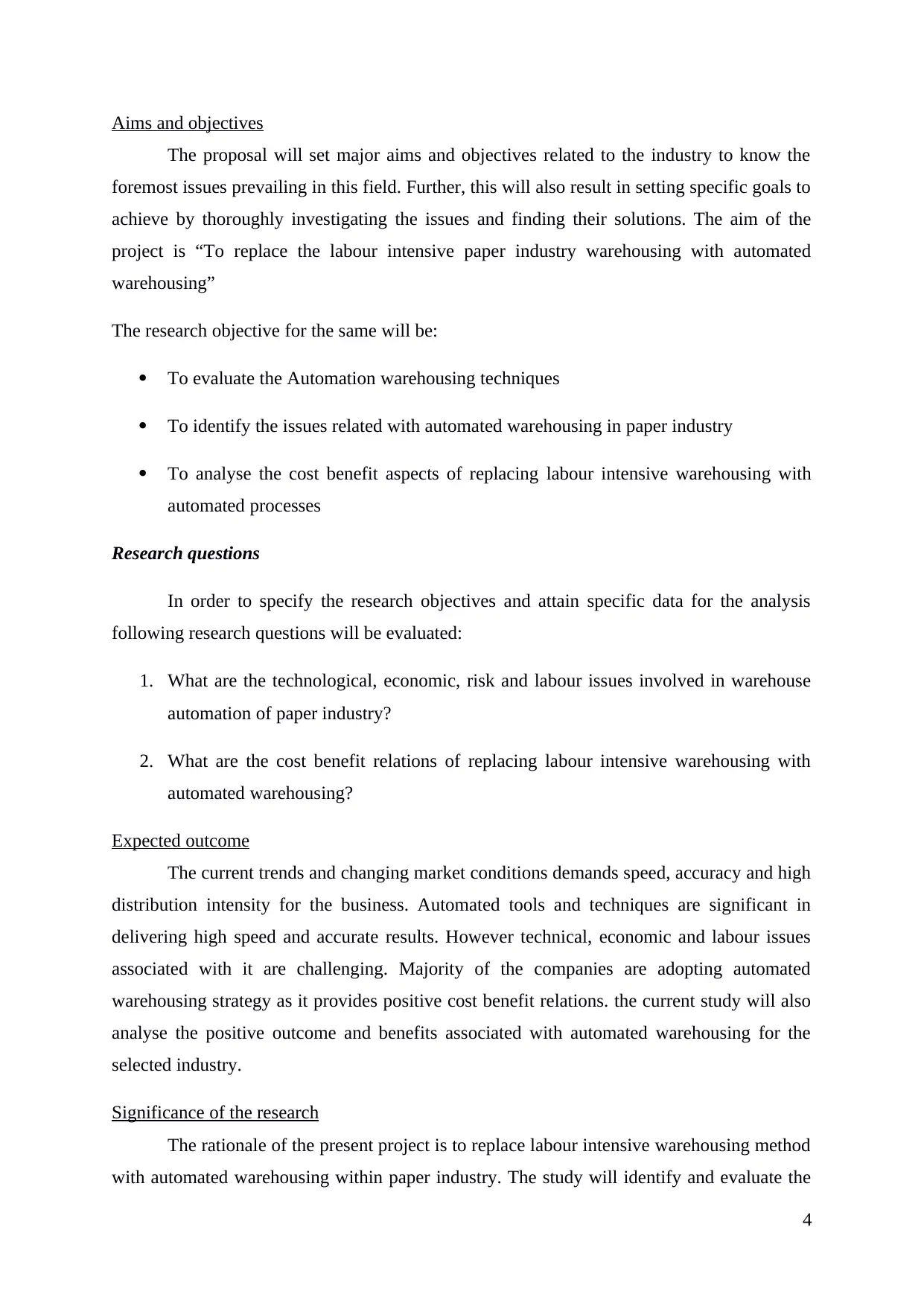
Aims and objectives
The proposal will set major aims and objectives related to the industry to know the
foremost issues prevailing in this field. Further, this will also result in setting specific goals to
achieve by thoroughly investigating the issues and finding their solutions. The aim of the
project is “To replace the labour intensive paper industry warehousing with automated
warehousing”
The research objective for the same will be:
To evaluate the Automation warehousing techniques
To identify the issues related with automated warehousing in paper industry
To analyse the cost benefit aspects of replacing labour intensive warehousing with
automated processes
Research questions
In order to specify the research objectives and attain specific data for the analysis
following research questions will be evaluated:
1. What are the technological, economic, risk and labour issues involved in warehouse
automation of paper industry?
2. What are the cost benefit relations of replacing labour intensive warehousing with
automated warehousing?
Expected outcome
The current trends and changing market conditions demands speed, accuracy and high
distribution intensity for the business. Automated tools and techniques are significant in
delivering high speed and accurate results. However technical, economic and labour issues
associated with it are challenging. Majority of the companies are adopting automated
warehousing strategy as it provides positive cost benefit relations. the current study will also
analyse the positive outcome and benefits associated with automated warehousing for the
selected industry.
Significance of the research
The rationale of the present project is to replace labour intensive warehousing method
with automated warehousing within paper industry. The study will identify and evaluate the
4
The proposal will set major aims and objectives related to the industry to know the
foremost issues prevailing in this field. Further, this will also result in setting specific goals to
achieve by thoroughly investigating the issues and finding their solutions. The aim of the
project is “To replace the labour intensive paper industry warehousing with automated
warehousing”
The research objective for the same will be:
To evaluate the Automation warehousing techniques
To identify the issues related with automated warehousing in paper industry
To analyse the cost benefit aspects of replacing labour intensive warehousing with
automated processes
Research questions
In order to specify the research objectives and attain specific data for the analysis
following research questions will be evaluated:
1. What are the technological, economic, risk and labour issues involved in warehouse
automation of paper industry?
2. What are the cost benefit relations of replacing labour intensive warehousing with
automated warehousing?
Expected outcome
The current trends and changing market conditions demands speed, accuracy and high
distribution intensity for the business. Automated tools and techniques are significant in
delivering high speed and accurate results. However technical, economic and labour issues
associated with it are challenging. Majority of the companies are adopting automated
warehousing strategy as it provides positive cost benefit relations. the current study will also
analyse the positive outcome and benefits associated with automated warehousing for the
selected industry.
Significance of the research
The rationale of the present project is to replace labour intensive warehousing method
with automated warehousing within paper industry. The study will identify and evaluate the
4
Paraphrase This Document
Need a fresh take? Get an instant paraphrase of this document with our AI Paraphraser
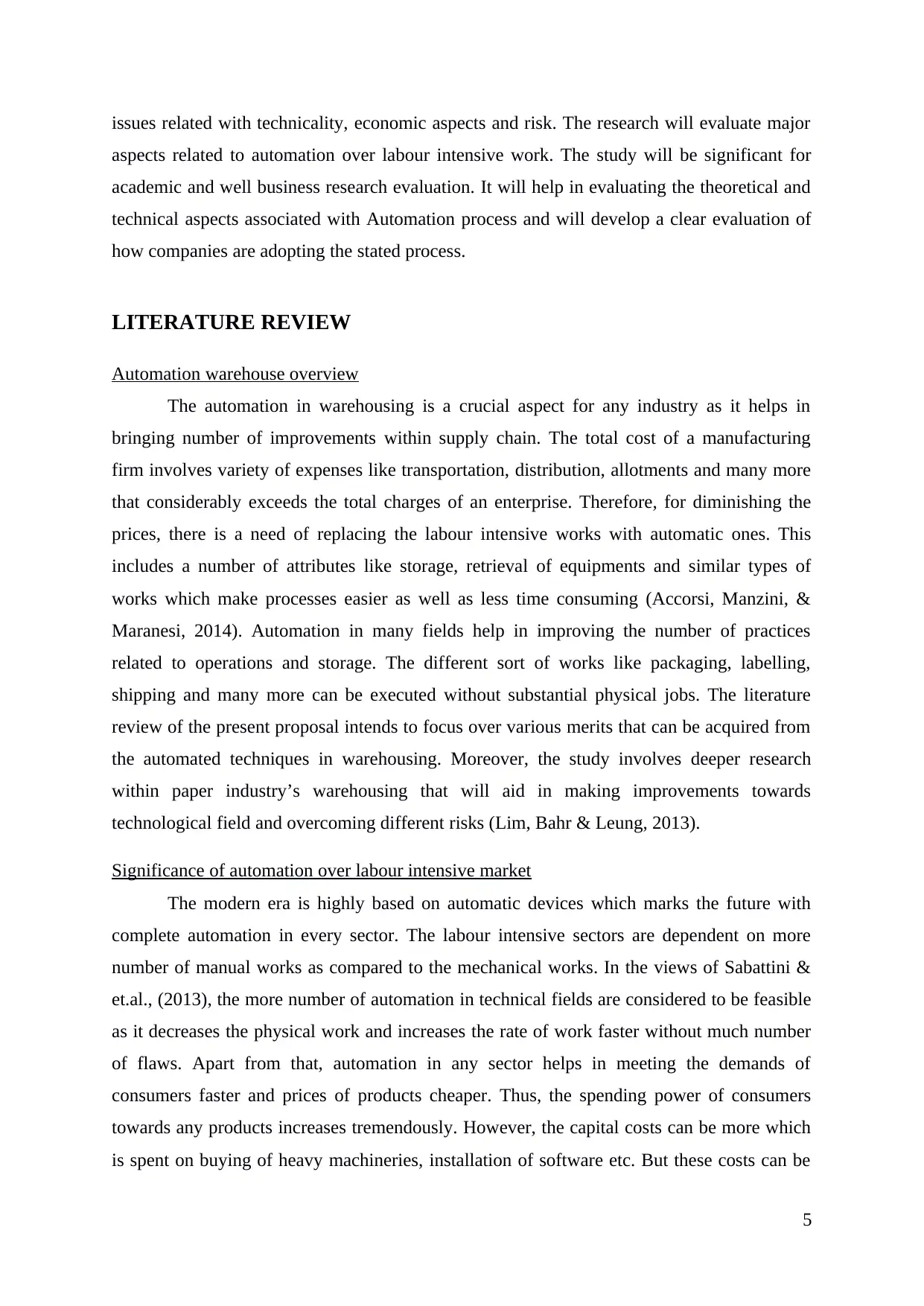
issues related with technicality, economic aspects and risk. The research will evaluate major
aspects related to automation over labour intensive work. The study will be significant for
academic and well business research evaluation. It will help in evaluating the theoretical and
technical aspects associated with Automation process and will develop a clear evaluation of
how companies are adopting the stated process.
LITERATURE REVIEW
Automation warehouse overview
The automation in warehousing is a crucial aspect for any industry as it helps in
bringing number of improvements within supply chain. The total cost of a manufacturing
firm involves variety of expenses like transportation, distribution, allotments and many more
that considerably exceeds the total charges of an enterprise. Therefore, for diminishing the
prices, there is a need of replacing the labour intensive works with automatic ones. This
includes a number of attributes like storage, retrieval of equipments and similar types of
works which make processes easier as well as less time consuming (Accorsi, Manzini, &
Maranesi, 2014). Automation in many fields help in improving the number of practices
related to operations and storage. The different sort of works like packaging, labelling,
shipping and many more can be executed without substantial physical jobs. The literature
review of the present proposal intends to focus over various merits that can be acquired from
the automated techniques in warehousing. Moreover, the study involves deeper research
within paper industry’s warehousing that will aid in making improvements towards
technological field and overcoming different risks (Lim, Bahr & Leung, 2013).
Significance of automation over labour intensive market
The modern era is highly based on automatic devices which marks the future with
complete automation in every sector. The labour intensive sectors are dependent on more
number of manual works as compared to the mechanical works. In the views of Sabattini &
et.al., (2013), the more number of automation in technical fields are considered to be feasible
as it decreases the physical work and increases the rate of work faster without much number
of flaws. Apart from that, automation in any sector helps in meeting the demands of
consumers faster and prices of products cheaper. Thus, the spending power of consumers
towards any products increases tremendously. However, the capital costs can be more which
is spent on buying of heavy machineries, installation of software etc. But these costs can be
5
aspects related to automation over labour intensive work. The study will be significant for
academic and well business research evaluation. It will help in evaluating the theoretical and
technical aspects associated with Automation process and will develop a clear evaluation of
how companies are adopting the stated process.
LITERATURE REVIEW
Automation warehouse overview
The automation in warehousing is a crucial aspect for any industry as it helps in
bringing number of improvements within supply chain. The total cost of a manufacturing
firm involves variety of expenses like transportation, distribution, allotments and many more
that considerably exceeds the total charges of an enterprise. Therefore, for diminishing the
prices, there is a need of replacing the labour intensive works with automatic ones. This
includes a number of attributes like storage, retrieval of equipments and similar types of
works which make processes easier as well as less time consuming (Accorsi, Manzini, &
Maranesi, 2014). Automation in many fields help in improving the number of practices
related to operations and storage. The different sort of works like packaging, labelling,
shipping and many more can be executed without substantial physical jobs. The literature
review of the present proposal intends to focus over various merits that can be acquired from
the automated techniques in warehousing. Moreover, the study involves deeper research
within paper industry’s warehousing that will aid in making improvements towards
technological field and overcoming different risks (Lim, Bahr & Leung, 2013).
Significance of automation over labour intensive market
The modern era is highly based on automatic devices which marks the future with
complete automation in every sector. The labour intensive sectors are dependent on more
number of manual works as compared to the mechanical works. In the views of Sabattini &
et.al., (2013), the more number of automation in technical fields are considered to be feasible
as it decreases the physical work and increases the rate of work faster without much number
of flaws. Apart from that, automation in any sector helps in meeting the demands of
consumers faster and prices of products cheaper. Thus, the spending power of consumers
towards any products increases tremendously. However, the capital costs can be more which
is spent on buying of heavy machineries, installation of software etc. But these costs can be
5
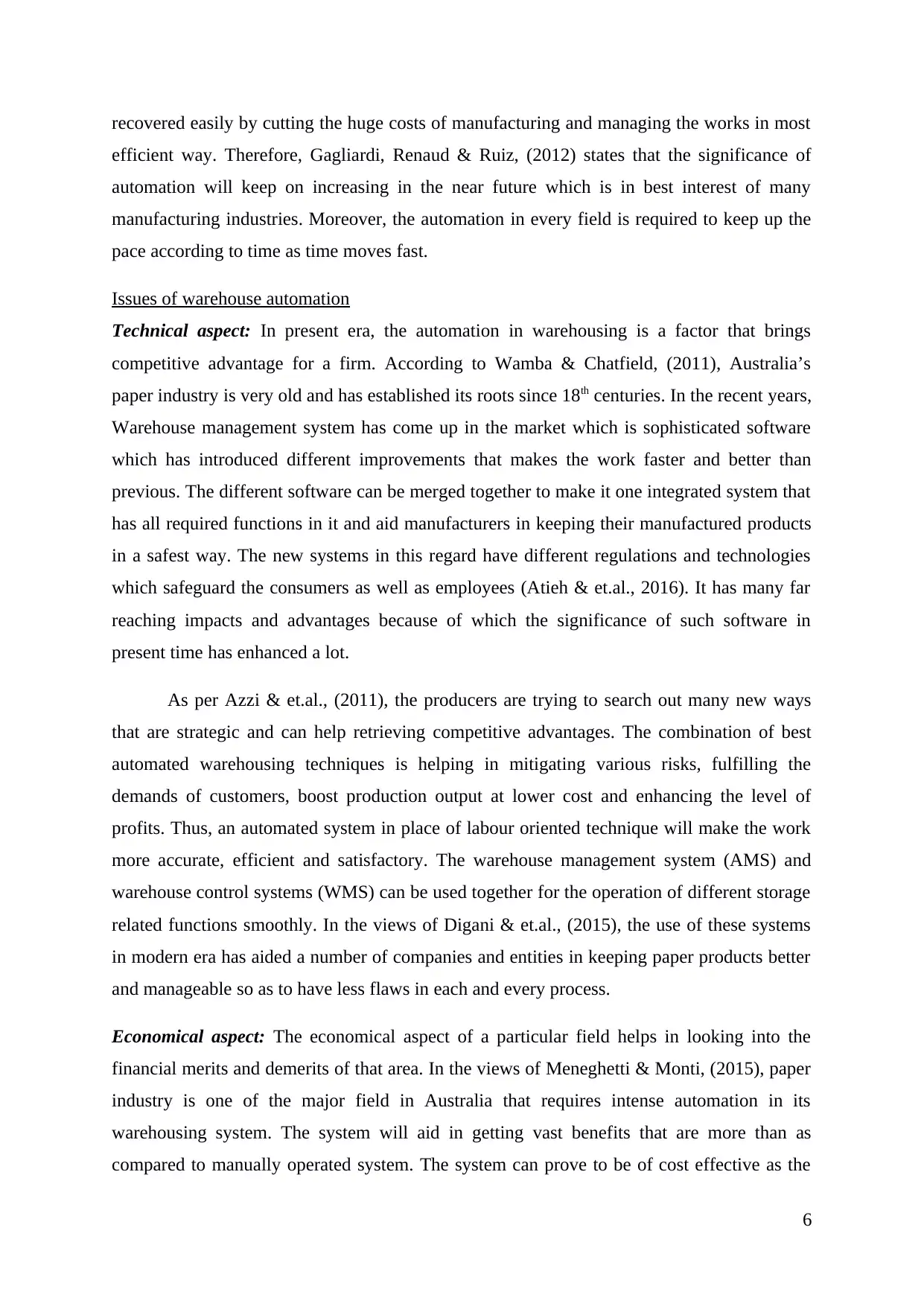
recovered easily by cutting the huge costs of manufacturing and managing the works in most
efficient way. Therefore, Gagliardi, Renaud & Ruiz, (2012) states that the significance of
automation will keep on increasing in the near future which is in best interest of many
manufacturing industries. Moreover, the automation in every field is required to keep up the
pace according to time as time moves fast.
Issues of warehouse automation
Technical aspect: In present era, the automation in warehousing is a factor that brings
competitive advantage for a firm. According to Wamba & Chatfield, (2011), Australia’s
paper industry is very old and has established its roots since 18th centuries. In the recent years,
Warehouse management system has come up in the market which is sophisticated software
which has introduced different improvements that makes the work faster and better than
previous. The different software can be merged together to make it one integrated system that
has all required functions in it and aid manufacturers in keeping their manufactured products
in a safest way. The new systems in this regard have different regulations and technologies
which safeguard the consumers as well as employees (Atieh & et.al., 2016). It has many far
reaching impacts and advantages because of which the significance of such software in
present time has enhanced a lot.
As per Azzi & et.al., (2011), the producers are trying to search out many new ways
that are strategic and can help retrieving competitive advantages. The combination of best
automated warehousing techniques is helping in mitigating various risks, fulfilling the
demands of customers, boost production output at lower cost and enhancing the level of
profits. Thus, an automated system in place of labour oriented technique will make the work
more accurate, efficient and satisfactory. The warehouse management system (AMS) and
warehouse control systems (WMS) can be used together for the operation of different storage
related functions smoothly. In the views of Digani & et.al., (2015), the use of these systems
in modern era has aided a number of companies and entities in keeping paper products better
and manageable so as to have less flaws in each and every process.
Economical aspect: The economical aspect of a particular field helps in looking into the
financial merits and demerits of that area. In the views of Meneghetti & Monti, (2015), paper
industry is one of the major field in Australia that requires intense automation in its
warehousing system. The system will aid in getting vast benefits that are more than as
compared to manually operated system. The system can prove to be of cost effective as the
6
efficient way. Therefore, Gagliardi, Renaud & Ruiz, (2012) states that the significance of
automation will keep on increasing in the near future which is in best interest of many
manufacturing industries. Moreover, the automation in every field is required to keep up the
pace according to time as time moves fast.
Issues of warehouse automation
Technical aspect: In present era, the automation in warehousing is a factor that brings
competitive advantage for a firm. According to Wamba & Chatfield, (2011), Australia’s
paper industry is very old and has established its roots since 18th centuries. In the recent years,
Warehouse management system has come up in the market which is sophisticated software
which has introduced different improvements that makes the work faster and better than
previous. The different software can be merged together to make it one integrated system that
has all required functions in it and aid manufacturers in keeping their manufactured products
in a safest way. The new systems in this regard have different regulations and technologies
which safeguard the consumers as well as employees (Atieh & et.al., 2016). It has many far
reaching impacts and advantages because of which the significance of such software in
present time has enhanced a lot.
As per Azzi & et.al., (2011), the producers are trying to search out many new ways
that are strategic and can help retrieving competitive advantages. The combination of best
automated warehousing techniques is helping in mitigating various risks, fulfilling the
demands of customers, boost production output at lower cost and enhancing the level of
profits. Thus, an automated system in place of labour oriented technique will make the work
more accurate, efficient and satisfactory. The warehouse management system (AMS) and
warehouse control systems (WMS) can be used together for the operation of different storage
related functions smoothly. In the views of Digani & et.al., (2015), the use of these systems
in modern era has aided a number of companies and entities in keeping paper products better
and manageable so as to have less flaws in each and every process.
Economical aspect: The economical aspect of a particular field helps in looking into the
financial merits and demerits of that area. In the views of Meneghetti & Monti, (2015), paper
industry is one of the major field in Australia that requires intense automation in its
warehousing system. The system will aid in getting vast benefits that are more than as
compared to manually operated system. The system can prove to be of cost effective as the
6
⊘ This is a preview!⊘
Do you want full access?
Subscribe today to unlock all pages.

Trusted by 1+ million students worldwide
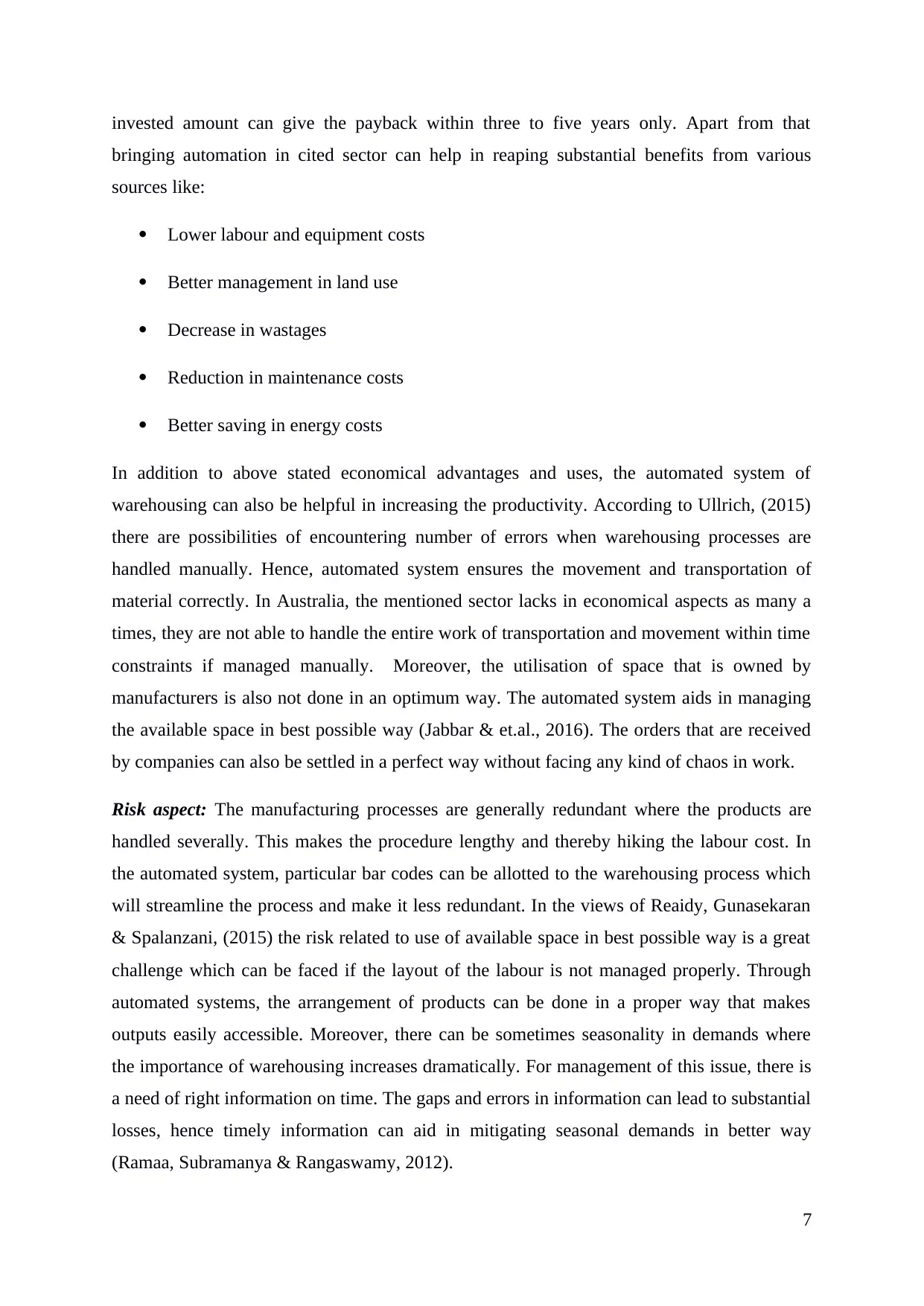
invested amount can give the payback within three to five years only. Apart from that
bringing automation in cited sector can help in reaping substantial benefits from various
sources like:
Lower labour and equipment costs
Better management in land use
Decrease in wastages
Reduction in maintenance costs
Better saving in energy costs
In addition to above stated economical advantages and uses, the automated system of
warehousing can also be helpful in increasing the productivity. According to Ullrich, (2015)
there are possibilities of encountering number of errors when warehousing processes are
handled manually. Hence, automated system ensures the movement and transportation of
material correctly. In Australia, the mentioned sector lacks in economical aspects as many a
times, they are not able to handle the entire work of transportation and movement within time
constraints if managed manually. Moreover, the utilisation of space that is owned by
manufacturers is also not done in an optimum way. The automated system aids in managing
the available space in best possible way (Jabbar & et.al., 2016). The orders that are received
by companies can also be settled in a perfect way without facing any kind of chaos in work.
Risk aspect: The manufacturing processes are generally redundant where the products are
handled severally. This makes the procedure lengthy and thereby hiking the labour cost. In
the automated system, particular bar codes can be allotted to the warehousing process which
will streamline the process and make it less redundant. In the views of Reaidy, Gunasekaran
& Spalanzani, (2015) the risk related to use of available space in best possible way is a great
challenge which can be faced if the layout of the labour is not managed properly. Through
automated systems, the arrangement of products can be done in a proper way that makes
outputs easily accessible. Moreover, there can be sometimes seasonality in demands where
the importance of warehousing increases dramatically. For management of this issue, there is
a need of right information on time. The gaps and errors in information can lead to substantial
losses, hence timely information can aid in mitigating seasonal demands in better way
(Ramaa, Subramanya & Rangaswamy, 2012).
7
bringing automation in cited sector can help in reaping substantial benefits from various
sources like:
Lower labour and equipment costs
Better management in land use
Decrease in wastages
Reduction in maintenance costs
Better saving in energy costs
In addition to above stated economical advantages and uses, the automated system of
warehousing can also be helpful in increasing the productivity. According to Ullrich, (2015)
there are possibilities of encountering number of errors when warehousing processes are
handled manually. Hence, automated system ensures the movement and transportation of
material correctly. In Australia, the mentioned sector lacks in economical aspects as many a
times, they are not able to handle the entire work of transportation and movement within time
constraints if managed manually. Moreover, the utilisation of space that is owned by
manufacturers is also not done in an optimum way. The automated system aids in managing
the available space in best possible way (Jabbar & et.al., 2016). The orders that are received
by companies can also be settled in a perfect way without facing any kind of chaos in work.
Risk aspect: The manufacturing processes are generally redundant where the products are
handled severally. This makes the procedure lengthy and thereby hiking the labour cost. In
the automated system, particular bar codes can be allotted to the warehousing process which
will streamline the process and make it less redundant. In the views of Reaidy, Gunasekaran
& Spalanzani, (2015) the risk related to use of available space in best possible way is a great
challenge which can be faced if the layout of the labour is not managed properly. Through
automated systems, the arrangement of products can be done in a proper way that makes
outputs easily accessible. Moreover, there can be sometimes seasonality in demands where
the importance of warehousing increases dramatically. For management of this issue, there is
a need of right information on time. The gaps and errors in information can lead to substantial
losses, hence timely information can aid in mitigating seasonal demands in better way
(Ramaa, Subramanya & Rangaswamy, 2012).
7
Paraphrase This Document
Need a fresh take? Get an instant paraphrase of this document with our AI Paraphraser
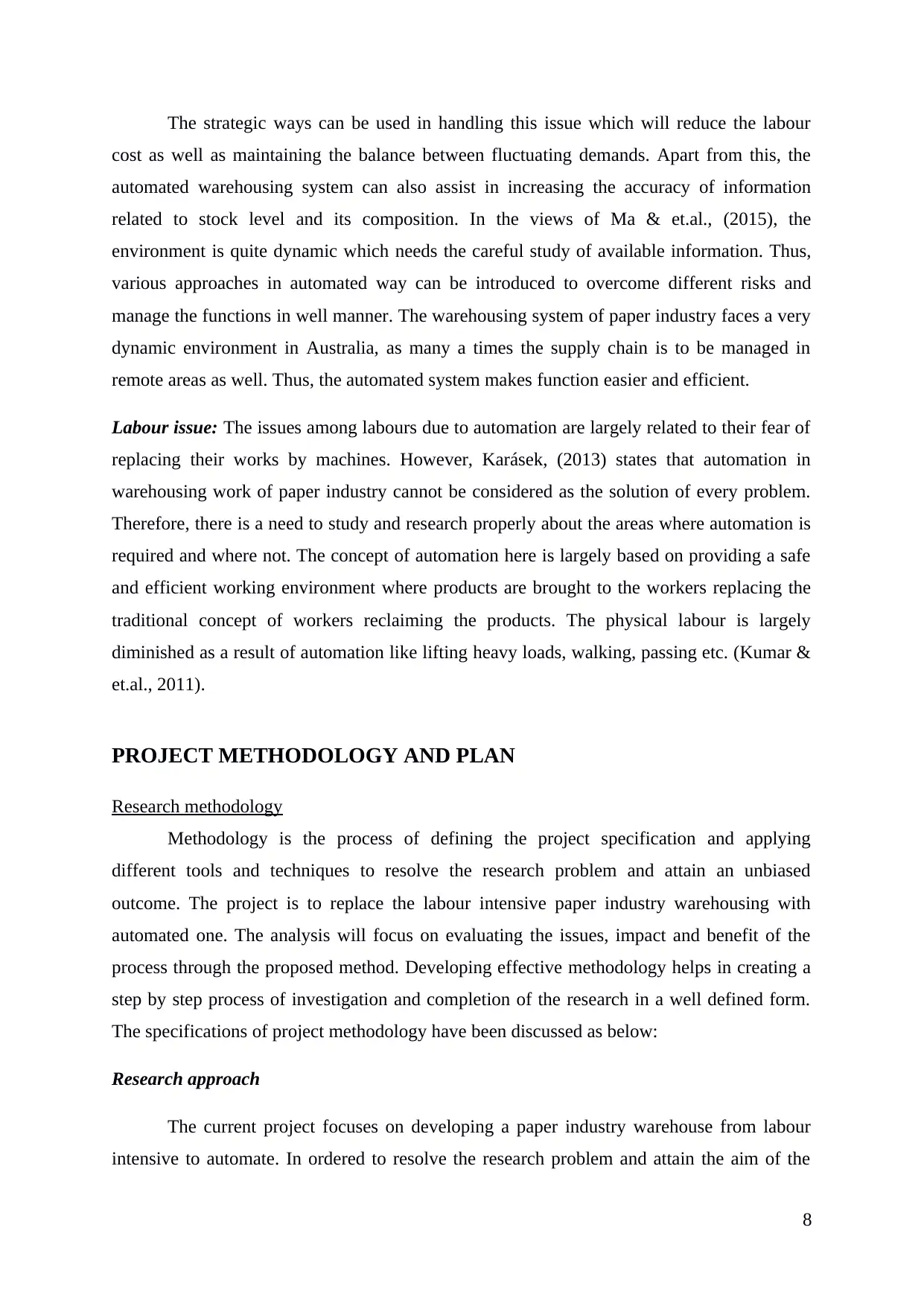
The strategic ways can be used in handling this issue which will reduce the labour
cost as well as maintaining the balance between fluctuating demands. Apart from this, the
automated warehousing system can also assist in increasing the accuracy of information
related to stock level and its composition. In the views of Ma & et.al., (2015), the
environment is quite dynamic which needs the careful study of available information. Thus,
various approaches in automated way can be introduced to overcome different risks and
manage the functions in well manner. The warehousing system of paper industry faces a very
dynamic environment in Australia, as many a times the supply chain is to be managed in
remote areas as well. Thus, the automated system makes function easier and efficient.
Labour issue: The issues among labours due to automation are largely related to their fear of
replacing their works by machines. However, Karásek, (2013) states that automation in
warehousing work of paper industry cannot be considered as the solution of every problem.
Therefore, there is a need to study and research properly about the areas where automation is
required and where not. The concept of automation here is largely based on providing a safe
and efficient working environment where products are brought to the workers replacing the
traditional concept of workers reclaiming the products. The physical labour is largely
diminished as a result of automation like lifting heavy loads, walking, passing etc. (Kumar &
et.al., 2011).
PROJECT METHODOLOGY AND PLAN
Research methodology
Methodology is the process of defining the project specification and applying
different tools and techniques to resolve the research problem and attain an unbiased
outcome. The project is to replace the labour intensive paper industry warehousing with
automated one. The analysis will focus on evaluating the issues, impact and benefit of the
process through the proposed method. Developing effective methodology helps in creating a
step by step process of investigation and completion of the research in a well defined form.
The specifications of project methodology have been discussed as below:
Research approach
The current project focuses on developing a paper industry warehouse from labour
intensive to automate. In ordered to resolve the research problem and attain the aim of the
8
cost as well as maintaining the balance between fluctuating demands. Apart from this, the
automated warehousing system can also assist in increasing the accuracy of information
related to stock level and its composition. In the views of Ma & et.al., (2015), the
environment is quite dynamic which needs the careful study of available information. Thus,
various approaches in automated way can be introduced to overcome different risks and
manage the functions in well manner. The warehousing system of paper industry faces a very
dynamic environment in Australia, as many a times the supply chain is to be managed in
remote areas as well. Thus, the automated system makes function easier and efficient.
Labour issue: The issues among labours due to automation are largely related to their fear of
replacing their works by machines. However, Karásek, (2013) states that automation in
warehousing work of paper industry cannot be considered as the solution of every problem.
Therefore, there is a need to study and research properly about the areas where automation is
required and where not. The concept of automation here is largely based on providing a safe
and efficient working environment where products are brought to the workers replacing the
traditional concept of workers reclaiming the products. The physical labour is largely
diminished as a result of automation like lifting heavy loads, walking, passing etc. (Kumar &
et.al., 2011).
PROJECT METHODOLOGY AND PLAN
Research methodology
Methodology is the process of defining the project specification and applying
different tools and techniques to resolve the research problem and attain an unbiased
outcome. The project is to replace the labour intensive paper industry warehousing with
automated one. The analysis will focus on evaluating the issues, impact and benefit of the
process through the proposed method. Developing effective methodology helps in creating a
step by step process of investigation and completion of the research in a well defined form.
The specifications of project methodology have been discussed as below:
Research approach
The current project focuses on developing a paper industry warehouse from labour
intensive to automate. In ordered to resolve the research problem and attain the aim of the
8
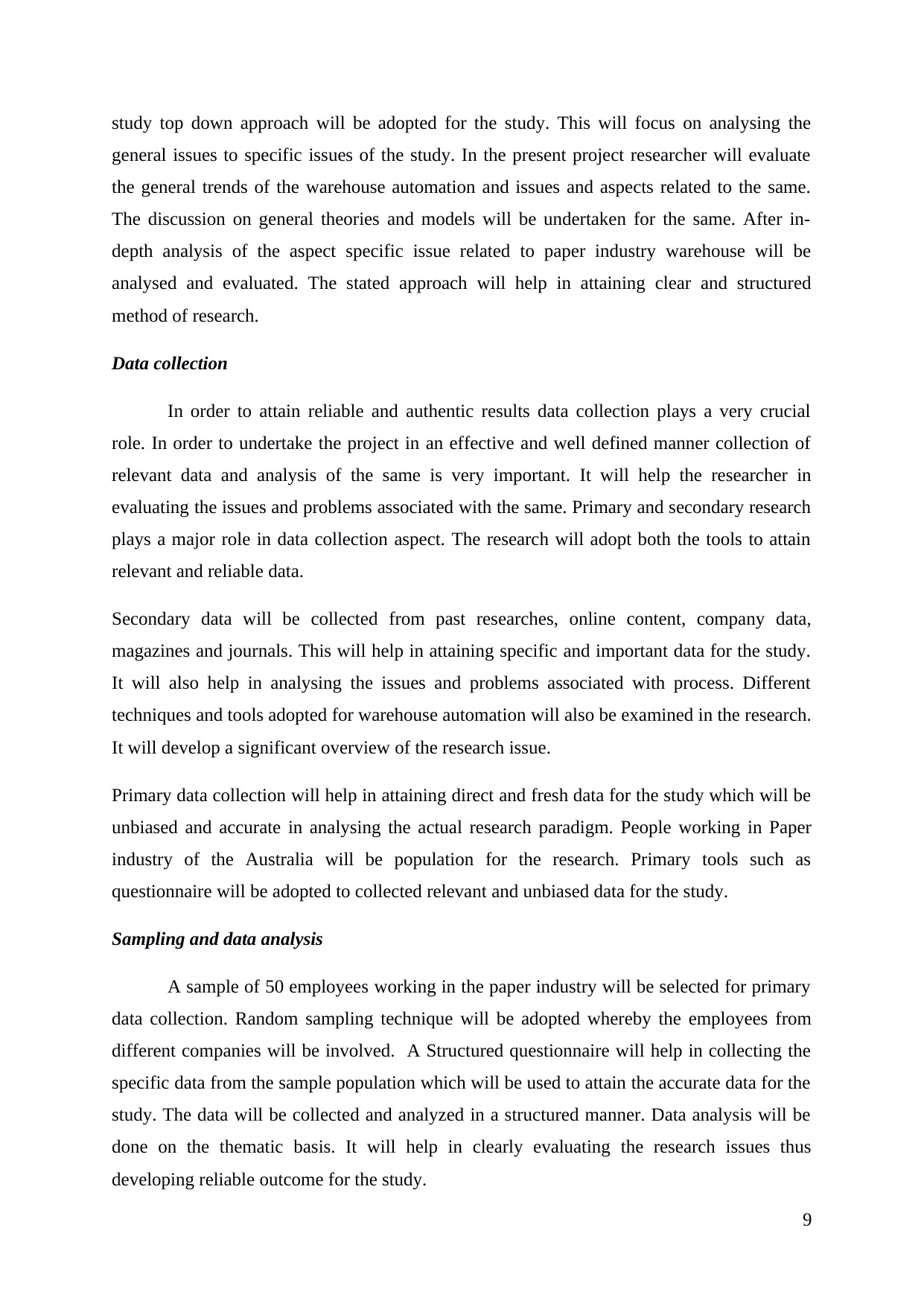
study top down approach will be adopted for the study. This will focus on analysing the
general issues to specific issues of the study. In the present project researcher will evaluate
the general trends of the warehouse automation and issues and aspects related to the same.
The discussion on general theories and models will be undertaken for the same. After in-
depth analysis of the aspect specific issue related to paper industry warehouse will be
analysed and evaluated. The stated approach will help in attaining clear and structured
method of research.
Data collection
In order to attain reliable and authentic results data collection plays a very crucial
role. In order to undertake the project in an effective and well defined manner collection of
relevant data and analysis of the same is very important. It will help the researcher in
evaluating the issues and problems associated with the same. Primary and secondary research
plays a major role in data collection aspect. The research will adopt both the tools to attain
relevant and reliable data.
Secondary data will be collected from past researches, online content, company data,
magazines and journals. This will help in attaining specific and important data for the study.
It will also help in analysing the issues and problems associated with process. Different
techniques and tools adopted for warehouse automation will also be examined in the research.
It will develop a significant overview of the research issue.
Primary data collection will help in attaining direct and fresh data for the study which will be
unbiased and accurate in analysing the actual research paradigm. People working in Paper
industry of the Australia will be population for the research. Primary tools such as
questionnaire will be adopted to collected relevant and unbiased data for the study.
Sampling and data analysis
A sample of 50 employees working in the paper industry will be selected for primary
data collection. Random sampling technique will be adopted whereby the employees from
different companies will be involved. A Structured questionnaire will help in collecting the
specific data from the sample population which will be used to attain the accurate data for the
study. The data will be collected and analyzed in a structured manner. Data analysis will be
done on the thematic basis. It will help in clearly evaluating the research issues thus
developing reliable outcome for the study.
9
general issues to specific issues of the study. In the present project researcher will evaluate
the general trends of the warehouse automation and issues and aspects related to the same.
The discussion on general theories and models will be undertaken for the same. After in-
depth analysis of the aspect specific issue related to paper industry warehouse will be
analysed and evaluated. The stated approach will help in attaining clear and structured
method of research.
Data collection
In order to attain reliable and authentic results data collection plays a very crucial
role. In order to undertake the project in an effective and well defined manner collection of
relevant data and analysis of the same is very important. It will help the researcher in
evaluating the issues and problems associated with the same. Primary and secondary research
plays a major role in data collection aspect. The research will adopt both the tools to attain
relevant and reliable data.
Secondary data will be collected from past researches, online content, company data,
magazines and journals. This will help in attaining specific and important data for the study.
It will also help in analysing the issues and problems associated with process. Different
techniques and tools adopted for warehouse automation will also be examined in the research.
It will develop a significant overview of the research issue.
Primary data collection will help in attaining direct and fresh data for the study which will be
unbiased and accurate in analysing the actual research paradigm. People working in Paper
industry of the Australia will be population for the research. Primary tools such as
questionnaire will be adopted to collected relevant and unbiased data for the study.
Sampling and data analysis
A sample of 50 employees working in the paper industry will be selected for primary
data collection. Random sampling technique will be adopted whereby the employees from
different companies will be involved. A Structured questionnaire will help in collecting the
specific data from the sample population which will be used to attain the accurate data for the
study. The data will be collected and analyzed in a structured manner. Data analysis will be
done on the thematic basis. It will help in clearly evaluating the research issues thus
developing reliable outcome for the study.
9
⊘ This is a preview!⊘
Do you want full access?
Subscribe today to unlock all pages.

Trusted by 1+ million students worldwide
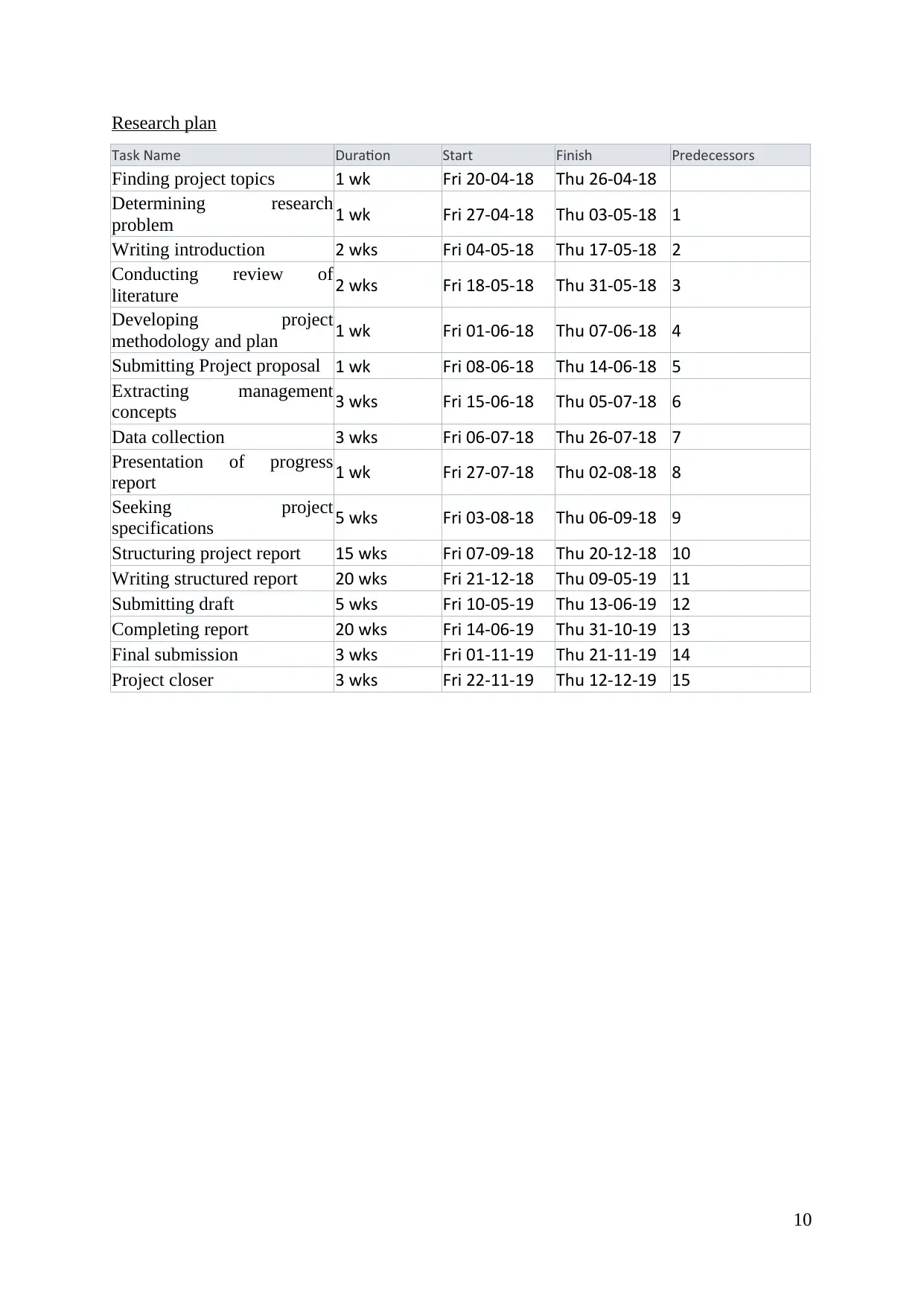
Research plan
Task Name Duration Start Finish Predecessors
Finding project topics 1 wk Fri 20-04-18 Thu 26-04-18
Determining research
problem 1 wk Fri 27-04-18 Thu 03-05-18 1
Writing introduction 2 wks Fri 04-05-18 Thu 17-05-18 2
Conducting review of
literature 2 wks Fri 18-05-18 Thu 31-05-18 3
Developing project
methodology and plan 1 wk Fri 01-06-18 Thu 07-06-18 4
Submitting Project proposal 1 wk Fri 08-06-18 Thu 14-06-18 5
Extracting management
concepts 3 wks Fri 15-06-18 Thu 05-07-18 6
Data collection 3 wks Fri 06-07-18 Thu 26-07-18 7
Presentation of progress
report 1 wk Fri 27-07-18 Thu 02-08-18 8
Seeking project
specifications 5 wks Fri 03-08-18 Thu 06-09-18 9
Structuring project report 15 wks Fri 07-09-18 Thu 20-12-18 10
Writing structured report 20 wks Fri 21-12-18 Thu 09-05-19 11
Submitting draft 5 wks Fri 10-05-19 Thu 13-06-19 12
Completing report 20 wks Fri 14-06-19 Thu 31-10-19 13
Final submission 3 wks Fri 01-11-19 Thu 21-11-19 14
Project closer 3 wks Fri 22-11-19 Thu 12-12-19 15
10
Task Name Duration Start Finish Predecessors
Finding project topics 1 wk Fri 20-04-18 Thu 26-04-18
Determining research
problem 1 wk Fri 27-04-18 Thu 03-05-18 1
Writing introduction 2 wks Fri 04-05-18 Thu 17-05-18 2
Conducting review of
literature 2 wks Fri 18-05-18 Thu 31-05-18 3
Developing project
methodology and plan 1 wk Fri 01-06-18 Thu 07-06-18 4
Submitting Project proposal 1 wk Fri 08-06-18 Thu 14-06-18 5
Extracting management
concepts 3 wks Fri 15-06-18 Thu 05-07-18 6
Data collection 3 wks Fri 06-07-18 Thu 26-07-18 7
Presentation of progress
report 1 wk Fri 27-07-18 Thu 02-08-18 8
Seeking project
specifications 5 wks Fri 03-08-18 Thu 06-09-18 9
Structuring project report 15 wks Fri 07-09-18 Thu 20-12-18 10
Writing structured report 20 wks Fri 21-12-18 Thu 09-05-19 11
Submitting draft 5 wks Fri 10-05-19 Thu 13-06-19 12
Completing report 20 wks Fri 14-06-19 Thu 31-10-19 13
Final submission 3 wks Fri 01-11-19 Thu 21-11-19 14
Project closer 3 wks Fri 22-11-19 Thu 12-12-19 15
10
Paraphrase This Document
Need a fresh take? Get an instant paraphrase of this document with our AI Paraphraser
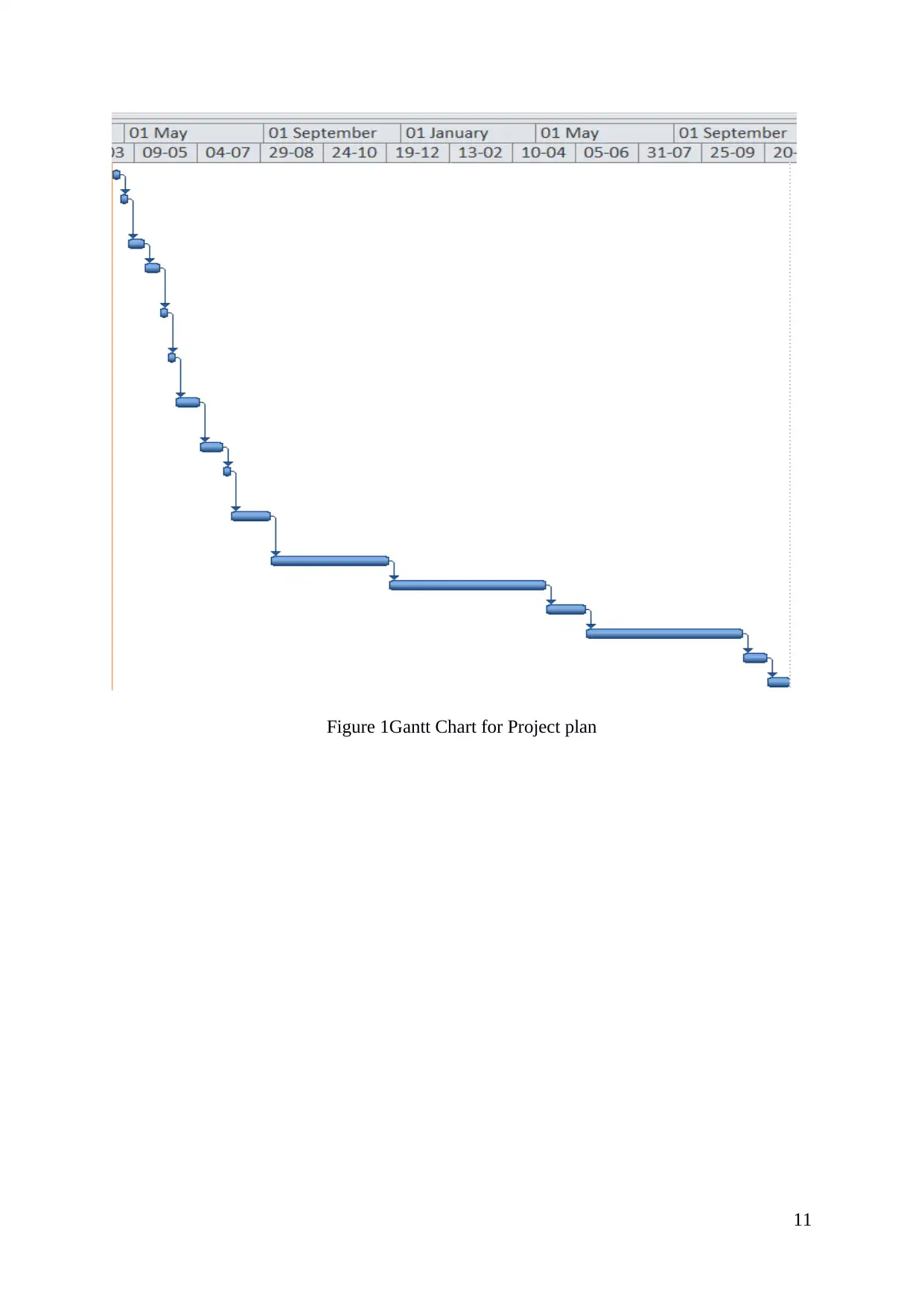
Figure 1Gantt Chart for Project plan
11
11
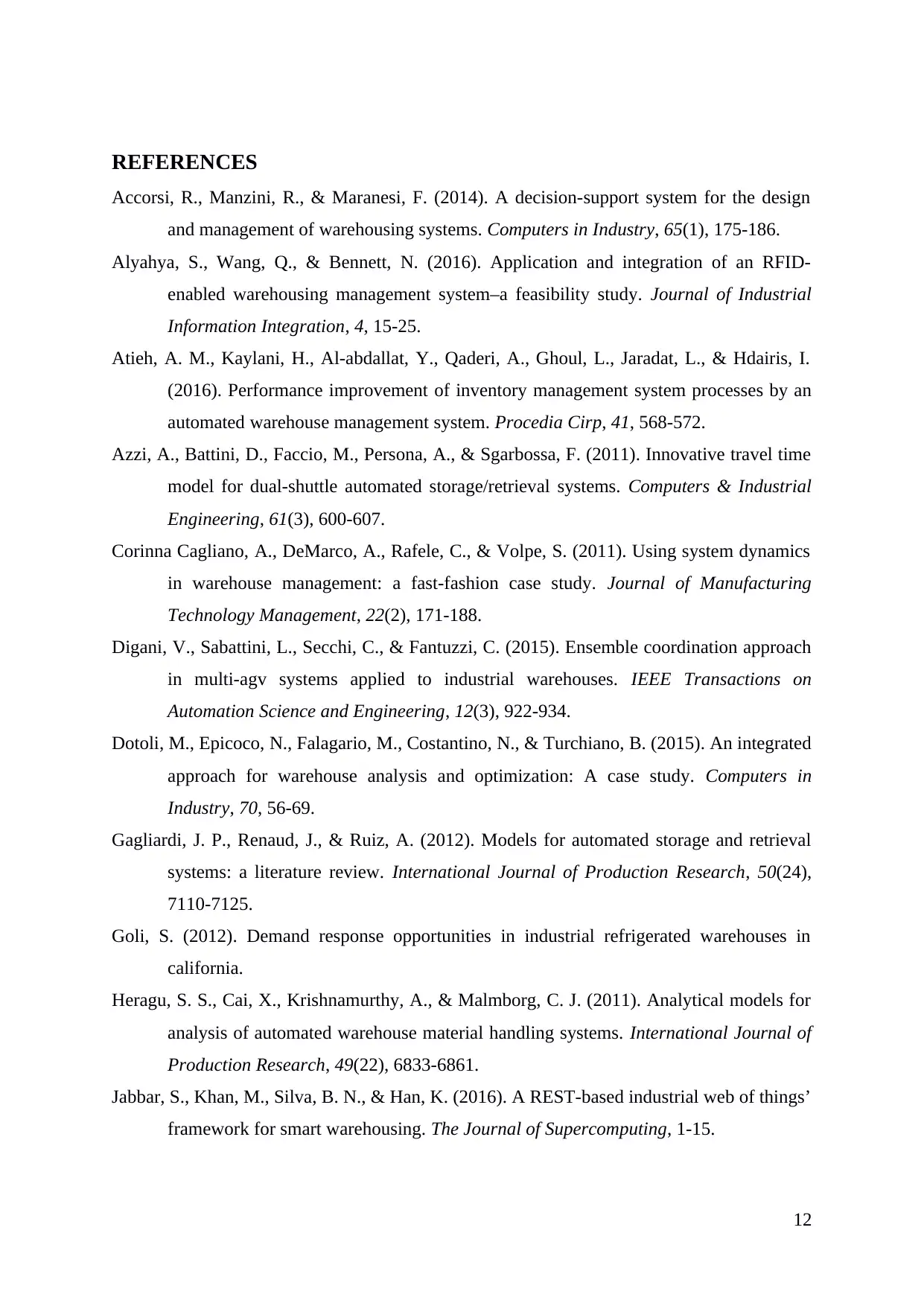
REFERENCES
Accorsi, R., Manzini, R., & Maranesi, F. (2014). A decision-support system for the design
and management of warehousing systems. Computers in Industry, 65(1), 175-186.
Alyahya, S., Wang, Q., & Bennett, N. (2016). Application and integration of an RFID-
enabled warehousing management system–a feasibility study. Journal of Industrial
Information Integration, 4, 15-25.
Atieh, A. M., Kaylani, H., Al-abdallat, Y., Qaderi, A., Ghoul, L., Jaradat, L., & Hdairis, I.
(2016). Performance improvement of inventory management system processes by an
automated warehouse management system. Procedia Cirp, 41, 568-572.
Azzi, A., Battini, D., Faccio, M., Persona, A., & Sgarbossa, F. (2011). Innovative travel time
model for dual-shuttle automated storage/retrieval systems. Computers & Industrial
Engineering, 61(3), 600-607.
Corinna Cagliano, A., DeMarco, A., Rafele, C., & Volpe, S. (2011). Using system dynamics
in warehouse management: a fast-fashion case study. Journal of Manufacturing
Technology Management, 22(2), 171-188.
Digani, V., Sabattini, L., Secchi, C., & Fantuzzi, C. (2015). Ensemble coordination approach
in multi-agv systems applied to industrial warehouses. IEEE Transactions on
Automation Science and Engineering, 12(3), 922-934.
Dotoli, M., Epicoco, N., Falagario, M., Costantino, N., & Turchiano, B. (2015). An integrated
approach for warehouse analysis and optimization: A case study. Computers in
Industry, 70, 56-69.
Gagliardi, J. P., Renaud, J., & Ruiz, A. (2012). Models for automated storage and retrieval
systems: a literature review. International Journal of Production Research, 50(24),
7110-7125.
Goli, S. (2012). Demand response opportunities in industrial refrigerated warehouses in
california.
Heragu, S. S., Cai, X., Krishnamurthy, A., & Malmborg, C. J. (2011). Analytical models for
analysis of automated warehouse material handling systems. International Journal of
Production Research, 49(22), 6833-6861.
Jabbar, S., Khan, M., Silva, B. N., & Han, K. (2016). A REST-based industrial web of things’
framework for smart warehousing. The Journal of Supercomputing, 1-15.
12
Accorsi, R., Manzini, R., & Maranesi, F. (2014). A decision-support system for the design
and management of warehousing systems. Computers in Industry, 65(1), 175-186.
Alyahya, S., Wang, Q., & Bennett, N. (2016). Application and integration of an RFID-
enabled warehousing management system–a feasibility study. Journal of Industrial
Information Integration, 4, 15-25.
Atieh, A. M., Kaylani, H., Al-abdallat, Y., Qaderi, A., Ghoul, L., Jaradat, L., & Hdairis, I.
(2016). Performance improvement of inventory management system processes by an
automated warehouse management system. Procedia Cirp, 41, 568-572.
Azzi, A., Battini, D., Faccio, M., Persona, A., & Sgarbossa, F. (2011). Innovative travel time
model for dual-shuttle automated storage/retrieval systems. Computers & Industrial
Engineering, 61(3), 600-607.
Corinna Cagliano, A., DeMarco, A., Rafele, C., & Volpe, S. (2011). Using system dynamics
in warehouse management: a fast-fashion case study. Journal of Manufacturing
Technology Management, 22(2), 171-188.
Digani, V., Sabattini, L., Secchi, C., & Fantuzzi, C. (2015). Ensemble coordination approach
in multi-agv systems applied to industrial warehouses. IEEE Transactions on
Automation Science and Engineering, 12(3), 922-934.
Dotoli, M., Epicoco, N., Falagario, M., Costantino, N., & Turchiano, B. (2015). An integrated
approach for warehouse analysis and optimization: A case study. Computers in
Industry, 70, 56-69.
Gagliardi, J. P., Renaud, J., & Ruiz, A. (2012). Models for automated storage and retrieval
systems: a literature review. International Journal of Production Research, 50(24),
7110-7125.
Goli, S. (2012). Demand response opportunities in industrial refrigerated warehouses in
california.
Heragu, S. S., Cai, X., Krishnamurthy, A., & Malmborg, C. J. (2011). Analytical models for
analysis of automated warehouse material handling systems. International Journal of
Production Research, 49(22), 6833-6861.
Jabbar, S., Khan, M., Silva, B. N., & Han, K. (2016). A REST-based industrial web of things’
framework for smart warehousing. The Journal of Supercomputing, 1-15.
12
⊘ This is a preview!⊘
Do you want full access?
Subscribe today to unlock all pages.

Trusted by 1+ million students worldwide
1 out of 13
Related Documents
Your All-in-One AI-Powered Toolkit for Academic Success.
+13062052269
info@desklib.com
Available 24*7 on WhatsApp / Email
![[object Object]](/_next/static/media/star-bottom.7253800d.svg)
Unlock your academic potential
Copyright © 2020–2025 A2Z Services. All Rights Reserved. Developed and managed by ZUCOL.





